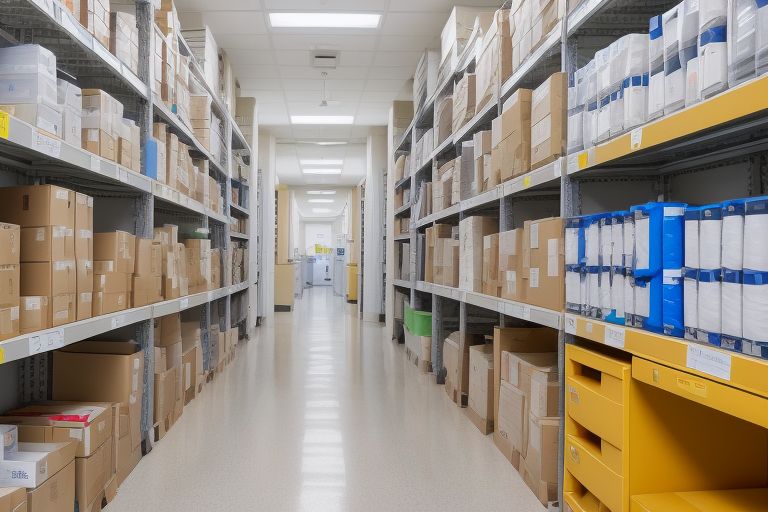A book on consignment inventory system for hospitals is a game-changer for managing medical supplies and equipment. This system allows hospitals to stock goods without owning them upfront, helping reduce waste and lower costs. If you’re new to this concept, don’t worry! This guide will explain everything you need to know about consignment inventory systems and how they can benefit hospitals.
Hospitals today face many challenges in managing their inventory. Keeping track of expensive medical items and ensuring they are always available for use can be tough. A book on consignment inventory system for hospitals helps hospitals stay organized and improve efficiency. By reading a detailed guide on this topic, you can understand the key strategies to keep your hospital’s supplies in check without overspending.
Table of Contents
How a Book on Consignment Inventory System Can Save Your Hospital Money

A book on consignment inventory system for hospitals can be the key to saving money and improving hospital operations. Hospitals spend a lot of money on medical supplies, and managing these costs can be tough. By using a consignment inventory system, you don’t need to buy everything upfront. This can help hospitals control their spending better.
In the book, you will find strategies to track how much stock is being used and when to order more. This makes it easier to avoid overstocking or understocking, which can be expensive. Instead of having unused items sitting in storage, you only pay for the products you use. This system helps hospitals stay within budget while still having the right supplies available when needed.
Key Benefits of Using a Consignment Inventory System for Hospitals: A Simple Explanation
Using a consignment inventory system brings several benefits to hospitals. First, it helps hospitals avoid paying for medical supplies they don’t need immediately. Instead, hospitals only pay for what they use. This method not only saves money but also makes inventory management easier.
Another benefit is that the book will show you how the system helps reduce waste. By keeping track of stock levels more efficiently, hospitals can avoid throwing away expired products. This leads to better use of resources, more space in storage, and lower costs for the hospital overall. The consignment system also helps reduce the risk of running out of essential supplies.
The Role of Consignment Inventory in Managing Hospital Supplies Effectively
Managing hospital supplies is an important task, and a consignment inventory system can make this job a lot easier. With this system, hospitals don’t need to worry about storing large quantities of supplies that might go unused. Instead, items are provided by suppliers and billed only when they are used. This reduces the need for large storage spaces and makes managing the stock much simpler.
A book on consignment inventory system for hospitals helps you understand how to set up and maintain this system in your hospital. It provides useful tips on how to track usage, monitor stock levels, and work closely with suppliers to keep everything running smoothly. The book also shows you how to create a system that is transparent, so you always know exactly what is in your inventory and when to reorder.
Step-by-Step Guide: How a Book on Consignment Inventory System Helps Hospitals Streamline Stock Management

A step-by-step guide in a book on consignment inventory system for hospitals is like having a roadmap to better inventory management. It walks you through each step, from understanding the system to applying it in your hospital. The guide explains how to organize the supplies and track them efficiently.
With clear instructions, you can set up your inventory system with ease. The book teaches you how to manage your stock levels and reduce waste by ensuring that only the necessary items are ordered. This process helps streamline the hospital’s operations and makes sure that supplies are always available when needed.
What’s Inside a Book on Consignment Inventory System for Hospitals Key Chapters and Insights
A book on consignment inventory system for hospitals is packed with useful information. The chapters break down complex ideas into simple steps that anyone can follow. From the basics of consignment inventory to more advanced techniques, the book gives you all the tools to make your hospital’s inventory system more efficient.
The book might include chapters on how to work with suppliers, how to track usage, and how to forecast future inventory needs. Each chapter is written to help hospitals get the most out of their consignment system, and it is easy to understand, even for people who are new to inventory management.
Top Mistakes Hospitals Make Without a Book on Consignment Inventory System and How to Avoid Them
Hospitals that don’t use a consignment inventory system often make mistakes that can cost them money. Without a system in place, hospitals may overstock, waste products, or run out of essential supplies. A book on consignment inventory system for hospitals helps you avoid these costly mistakes by providing expert advice.
The book shows you how to set up an effective system that reduces errors. By learning from the mistakes other hospitals have made, you can avoid repeating them. The guide teaches you how to streamline processes, work closely with suppliers, and create a transparent inventory system that keeps everything under control.
In summary, a book on consignment inventory system for hospitals is an invaluable resource that teaches hospitals how to manage their supplies more efficiently. It helps reduce costs, prevent waste, and ensure that hospitals always have what they need. By following the steps outlined in the book, hospitals can improve their inventory management, save money, and provide better care to their patients.
How to Get Started with a Consignment Inventory System for Hospitals

Getting started with a consignment inventory system for hospitals is easier than it might seem. The first step is to understand how the system works and how it can benefit your hospital. You need to make sure your hospital has the right tools, such as inventory tracking software or a system for manually recording stock levels. Once you have these tools in place, you can begin working with suppliers who offer consignment agreements.
Next, create a simple system to track usage. Hospitals need to know which supplies are used most often and when they need to be reordered. This can be done manually or with software that keeps track of stock levels in real-time. Regular checks will help ensure you’re never caught without important supplies and that you aren’t overstocking unnecessary items.
Another important step is building strong relationships with suppliers. Good communication with your suppliers helps ensure that your consignment inventory system runs smoothly. You’ll need to agree on how products will be delivered, how you’ll track usage, and how often you’ll be invoiced for the items you use. By working closely with suppliers, you can prevent any issues and ensure that your hospital always has the right medical supplies.
Finally, be sure to train your hospital staff on how to use the consignment inventory system. Whether it’s a software system or manual tracking, it’s important that everyone knows how to keep track of what’s being used and how to order more supplies when needed. Proper training will help ensure the system works well and that inventory management is as efficient as possible.
Conclusion
In conclusion, a book on consignment inventory system for hospitals can make a big difference in how hospitals manage their supplies. By using this system, hospitals can save money, reduce waste, and make sure they always have the medical items they need. The book gives easy steps and clear advice to help you set up and manage the system smoothly.
If you want to improve inventory management and cut down on unnecessary costs, a book on consignment inventory system for hospitals is a great choice. It’s packed with useful information to help you get started and keep everything organized. With the right guidance, hospitals can run more efficiently and focus on providing the best care to their patients.
FAQs
Q: What is a consignment inventory system for hospitals?
A: It’s a system where hospitals receive medical supplies on loan from suppliers and only pay for what they use, instead of paying upfront for all the items.
Q: How does a consignment inventory system save money?
A: It helps hospitals avoid overstocking or wasting supplies by only paying for the items they actually use.
Q: Why is inventory management important in hospitals?
A: Proper inventory management ensures hospitals have the right supplies at the right time, improving patient care and reducing costs.
Q: Can a book on consignment inventory system help beginners?
A: Yes, the book breaks down the system into simple steps, making it easy for anyone to understand and use.
Q: How do hospitals track consignment inventory?
A: Hospitals track usage and stock levels with a simple system, making sure to reorder supplies when needed without overbuying.



